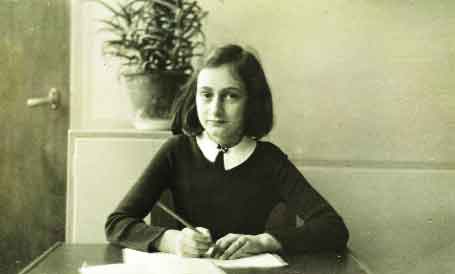A series of photographs, Anne Frank — A History for Today, showcases how personal accounts can help us understand events that shaped world history and their relevance in today’s age. By U Nair
When we think about the Netherlands, we not only think of tulips, canals and cheese, but even the story of Anne Frank. The tale of that little girl in the backdrop of the Second World War and the Holocaust is one of the greatest testimonies of triumph and courage.
Anne Frank — A History for Today highlights her story at the IIC. Her diary comprising vivid observations and experiences is one of the world’s most popularly read personal accounts of the Holocaust. Complete with quotations and the Frank family’s photographs, the exhibition showcases how personal accounts can give an authentic picture of contemporary history.
Anne the author
Between the age of 13 and 15, Anne wrote many short stories, fairy tales, essays and the beginning of a novel. Five notebooks and 300 loose pages meticulously handwritten during the war are remnants that talk to us about life and its many reflections for this young lass. Anne Frank kept her diary for almost two years while she, her family and four others hid in a “secret annex,” an attic in the company owned by Anne’s father, Otto, in Amsterdam. The Nazis raided their hideaway on August 4, 1944. Anne died in the Bergen-Belsen concentration camp in March, 1945. Her diary was later turned over to Otto Frank and was published in 1955.
Album of memories
I saw larger parts of this exhibition in 1993 at Washington DC. And looking at it so many years hence will no doubt be an exercise in recall and deeper reflections. I remember the curator telling us that the exhibit had a strange beginning: In 1978, an anonymous phone caller alerted the director of the Anne Frank house that she was sending a package that might interest everybody. A few days later, a box arrived containing the Franks’ albums of family photographs. They had disappeared along with the family’s other possessions when the Franks abandoned their home and went into hiding.
Experiences and exclusion
The exhibition connects her life story to modern experiences of discrimination and exclusion, based on interviews with youths of diverse backgrounds and identities.
The photographs form the heart of the exhibit and illustrate how ordinary life was for the Frank family before the Holocaust. The exhibition succeeds in creating a heartbreaking portrait of a world sliding into war, of a Jewish community paralysed by fear and of a girl trying to grow up while everything she knew crumbled around her.
On large picture panels, the exhibition presents Frank’s life from her birth in 1929 to her death in the Bergen-Belsen concentration camp in 1945 and relates her personal life story to the historical context of Hitler’s rise to power, World War II and the persecution of the Jews. Through photos and interviews, the visitors learn about how these young people see themselves, how they are viewed by society and what role prejudices play in their daily lives. Best however are her images in school and the portraits that hide a shy nervous smile.
(In collaboration with The Anne Frank House, Amsterdam, PeaceWorks, an initiative of The Seagull Foundation for the Arts and the Embassy of Netherlands in India, the collection is on display at the India International Centre (IIC) from April 18 to 29.)


























